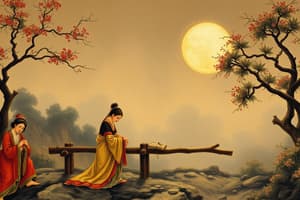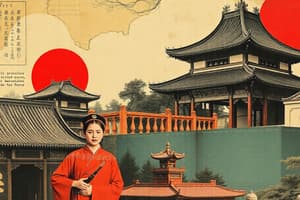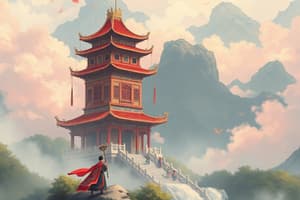Podcast
Questions and Answers
What was the reason for the cessation of Zheng Ho's expeditions in 1433?
What was the reason for the cessation of Zheng Ho's expeditions in 1433?
- Concerns over piracy in the Indian Ocean
- The death of Zheng Ho
- Lack of interest from the Emperor
- Belief that the expeditions were a waste of resources (correct)
Which dynasty was formed after the Ming Dynasty?
Which dynasty was formed after the Ming Dynasty?
- Ching Dynasty (correct)
- Han Dynasty
- Song Dynasty
- Yuan Dynasty
Which socio-economic belief influenced the status of merchants during the Ming Dynasty?
Which socio-economic belief influenced the status of merchants during the Ming Dynasty?
- Merchants were considered the highest status
- Merchants were completely disregarded in society
- Merchants had lower socioeconomic status than peasants (correct)
- Merchants had a status equal to that of farmers
What was significant about the Forbidden City?
What was significant about the Forbidden City?
What was the policy that the Ming and Qing Dynasties practiced regarding overseas exploration?
What was the policy that the Ming and Qing Dynasties practiced regarding overseas exploration?
What role did King George III play in relation to China?
What role did King George III play in relation to China?
What was one major consequence of the British smuggling opiates into China?
What was one major consequence of the British smuggling opiates into China?
Which ruler is associated with the peak of the Qing Dynasty?
Which ruler is associated with the peak of the Qing Dynasty?
What was an economic outcome of the tightly regulated trade system during the Ming Dynasty?
What was an economic outcome of the tightly regulated trade system during the Ming Dynasty?
Which event marked the decline of the Ming Dynasty?
Which event marked the decline of the Ming Dynasty?
Flashcards
Ming Dynasty in China
Ming Dynasty in China
Chinese dynasty that overthrew the Mongol Yuan Dynasty, known for exploration and later isolationism.
Zheng He's Expeditions
Zheng He's Expeditions
Sponsored by Yongle, these voyages explored the Indian Ocean, showcasing Chinese naval power.
Chinese Isolationism
Chinese Isolationism
Ming and Qing China's policy of limiting overseas trade and exploration.
Kowtow Ceremony
Kowtow Ceremony
Signup and view all the flashcards
Qing Dynasty
Qing Dynasty
Signup and view all the flashcards
Kangxi and Qianlong
Kangxi and Qianlong
Signup and view all the flashcards
Forbidden City
Forbidden City
Signup and view all the flashcards
Ming Dynasty Decline
Ming Dynasty Decline
Signup and view all the flashcards
Chinese Socioeconomic Structure
Chinese Socioeconomic Structure
Signup and view all the flashcards
British-China Trade Conflict
British-China Trade Conflict
Signup and view all the flashcards
Study Notes
Ming and Qing Dynasties in China
- The Mongols established the Yuan Dynasty, but were overthrown by the Chinese to form the Ming Dynasty.
- Hongwu, a peasant, founded the Ming Dynasty, succeeded by his son Yongle.
- Yongle sponsored Zheng He's voyages, exploring the Indian Ocean using advanced Chinese junks.
- Zheng He's voyages were halted in 1433, leading to European involvement in the Indian Ocean.
- China's isolationism followed, with regulated trade through key port cities and high taxes on European goods.
- This isolationism, while limiting outside influence, created a robust black market for luxury goods.
- Ming Dynasty merchants had higher economic status than peasants, but lower socio-economic status than land-owning peasants (reflecting Confucian ideals).
- The Ming Dynasty's decline began in the 17th century due to corruption, high taxation, and outside invasions.
- The Manchus (Jurchens) invaded in 1644, establishing the Qing Dynasty.
- The Qing Dynasty controlled China to the height of its power in the 18th century.
- The Qing Dynasty embraced Confucian ideals and rituals like the kowtow.
- The Qing Dynasty under Kangxi (1661–1722) and Qianlong (1735–1795) saw significant prosperity and population growth.
- The Qing declined as a response to the British refusing the kowtow ceremony and British opium smuggling.
Tokugawa Japan (summary)
- This section, though referenced in the study materials, requires further information than in these provided details to generate study notes. The provided content overlaps, but does not fully detail the Tokugawa period in Japan. Please provide separate and complete details.
Studying That Suits You
Use AI to generate personalized quizzes and flashcards to suit your learning preferences.




